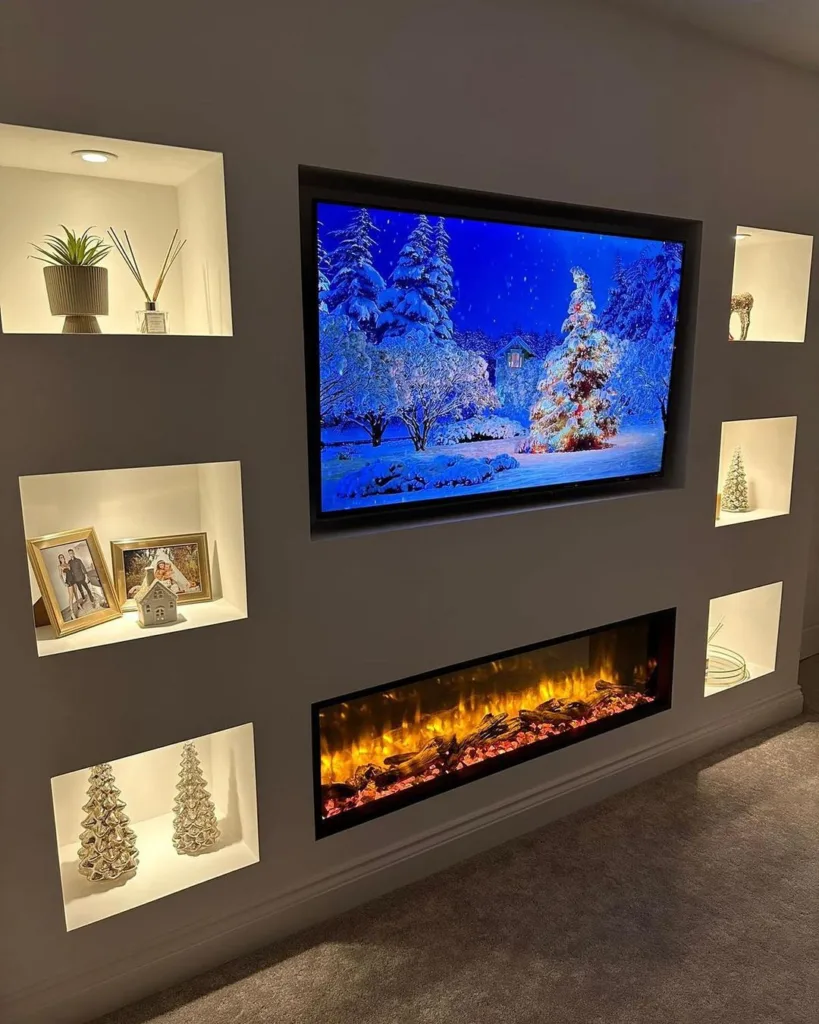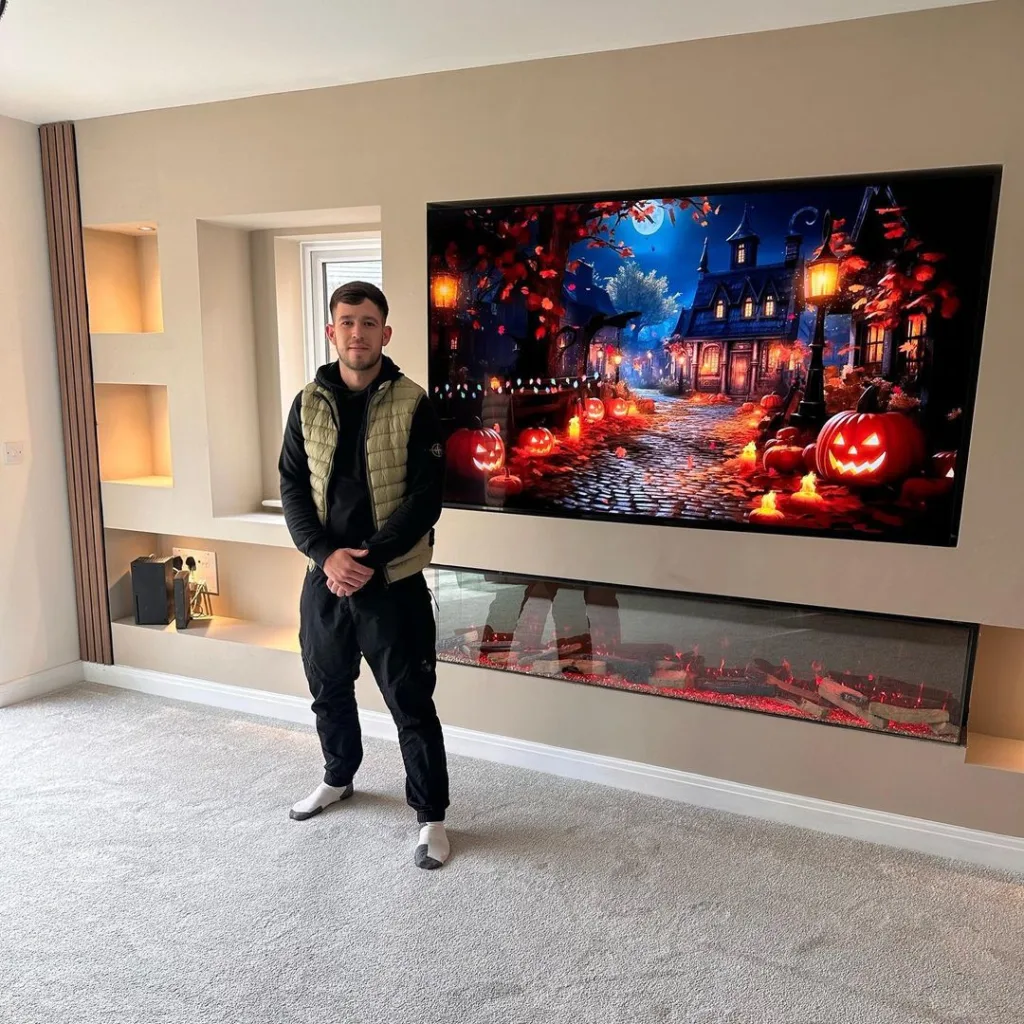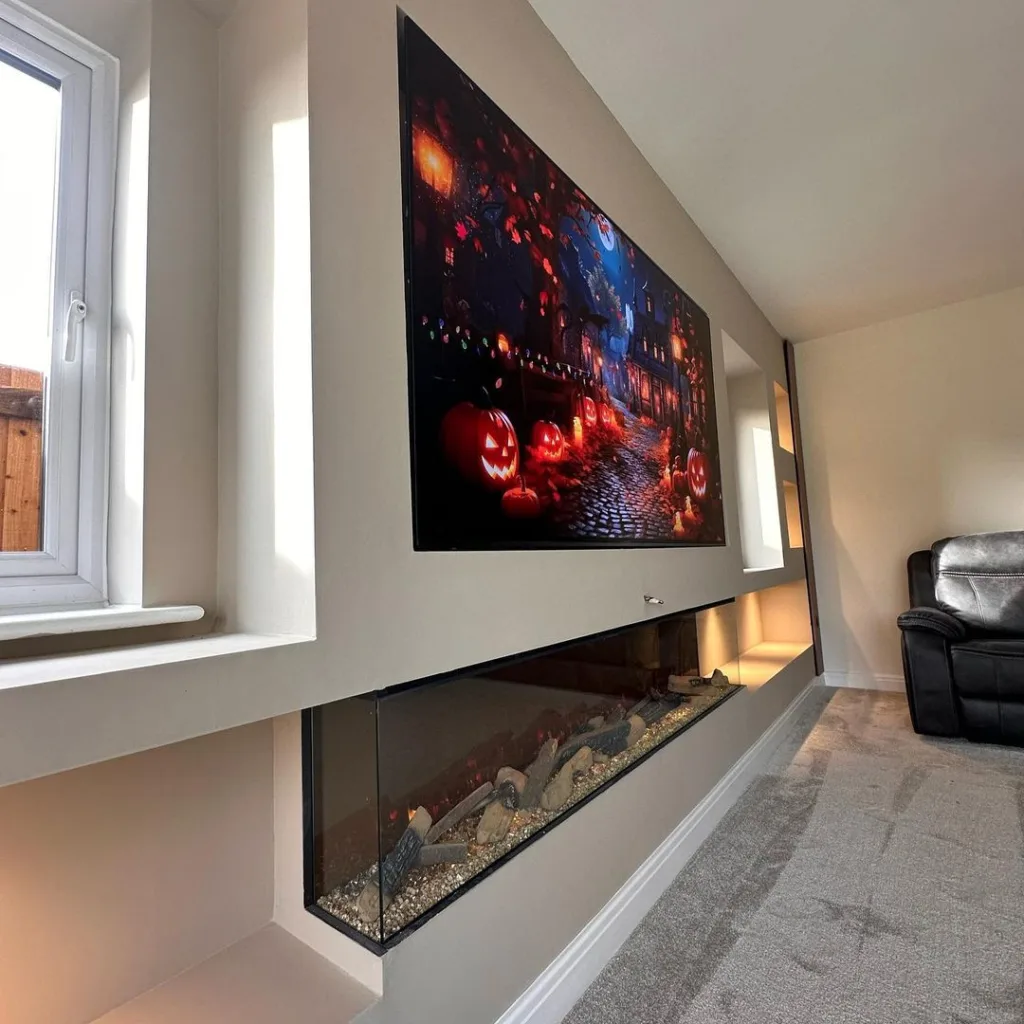Looking for the best built-in Media Wall/TV wall?
Media Wall/TV Wall Installation
Looking for a professional company to bring your Media Wall/TV Wall ideas to life? We have had so many happy customers over the past 3 years, which has made them fall in love with their home. Our TV wall installation begins with the drawing and measurement of your design. We then put the design into action from metalling, boarding, electrics, and finally plastering the finished masterpiece. Get in touch with us today to get a free quote!



Looking To Hide Your Wires In Your Wall?
Media Walls and TV Walls are perfect for not only keeping all your electrical goods hidden and neat but are the best solution to hide all the ugly wires. We all know how annoying it is not only to see the wires but to accidentally trip over them and hurt yourself or pull them out of the sockets. From TVs, Soundbars, and Virgin Boxes, Computer systems come with a lot of wires. See how we can help you today by giving us a call.

Light Up Your Media Wall or TV Wall
Nearly 90% of our customers with a TV wall installed have added LED lights to their feature wall. They are the perfect mood setting; whether watching a film or playing the computer, there is a light setting for every moment the lights being LED, they are tremendously cheap to have and will hardly increase your current electricity bill.


Media Wall FAQs
Building a media wall involves careful planning, design considerations, and a bit of DIY prowess. Here's a step-by-step guide to help you create a stunning media wall for your home:
1. Plan and Design:
- Measure the Space: Determine the dimensions of the wall where you plan to build the media wall. Consider the height, width, and any architectural features or obstacles.
- Sketch the Design: Create a rough sketch or use design software to visualize your media wall. Consider the placement of the TV, shelves, storage units, and any other features you want to include.
2. Choose Materials:
- Select Wall Material: Decide whether your media wall will be freestanding or built into the existing wall. For built-in walls, you may use materials like plywood, MDF, or drywall.
- Choose Finishes: Decide on the finishes for the media wall, such as paint colors, wallpapers, or decorative panels.
3. Prepare the Wall:
- Remove Existing Features: If you're integrating the media wall into an existing space, remove any furniture, fixtures, or obstacles.
- Prep the Wall Surface: Ensure the wall surface is smooth and clean. Patch any holes or imperfections and sand the surface for a clean finish.
4. Build the Frame:
- Construct a Stud Frame: If you're building a freestanding media wall, construct a sturdy frame using 2x4 or 2x6 lumber. For a built-in wall, locate and mark the wall studs for anchoring.
5. Add Shelving and Storage:
- Install Shelves: Determine the placement of shelves and install them securely. Adjustable shelves allow flexibility for different components and decorations.
- Incorporate Storage Units: If you want built-in storage, consider adding cabinets or drawers to hide electronics, DVDs, or other items.
6. Install Backing and Finishes:
- Add Backing Material: For a clean look and added stability, attach a backing material (plywood or MDF) to the frame.
- Apply Finishes: Paint or finish the media wall according to your design preferences. Consider using wallpaper, decorative panels, or textured finishes for added visual interest.
7. Mount the TV:
- Install Mounting Bracket: If your TV will be wall-mounted, install a secure mounting bracket to the wall. Ensure it is level and securely anchored to the studs.
- Mount the TV: Attach the TV to the mounting bracket according to the manufacturer's instructions. Conceal cables using cable management solutions for a clean look.
8. Add Lighting and Decor:
- Incorporate Lighting: Enhance the ambiance by adding LED strip lights, recessed lighting, or sconces. Consider smart lighting options for customizable settings.
- Personalize with Decor: Add decorative elements such as framed photos, artwork, or plants to personalize the media wall.
9. Integrate Technology:
- Install Tech Components: If you have entertainment components like speakers, gaming consoles, or a sound system, integrate them into the media wall. Use cable management solutions to keep wires organized.
10. Test and Adjust:
- Test All Components: Ensure that all components, including the TV, lights, and any tech equipment, are functioning properly.
- Make Adjustments: Fine-tune the arrangement of shelves, decor, and lighting to achieve the desired aesthetic and functionality.
Building a media wall requires careful attention to detail, and the success of your project depends on your specific needs and design preferences. If you're unsure about certain aspects, consider consulting with a professional or seeking guidance from online resources and tutorials.
A home media wall is a designated space within a residence that is specifically designed to house and showcase multimedia and entertainment components. This feature is often a central hub for home entertainment systems, providing a cohesive and organised solution for incorporating audio-visual equipment, storage, and decorative elements. Here are some key aspects of a home media wall:
- TV or Projection Screen: The focal point of a home media wall is typically a large-screen television or a projector screen. The size and type of display depend on the homeowner's preferences and the available space.
- Entertainment Components: A home media wall includes storage or shelving units to house audio-visual components such as gaming consoles, DVD or Blu-ray players, streaming devices, and sound systems. These components are often integrated or neatly arranged within the structure.
- Storage Solutions: Media walls often incorporate storage options for DVDs, Blu-rays, video games, remote controls, and other accessories. Cabinets, drawers, or open shelves may be included to keep the space organized.
- Design Elements: Homeowners can personalise their media walls to match their interior design preferences. This includes selecting materials, finishes, and colours that complement the overall aesthetic of the room.
- Cable Management: To maintain a clean and organised appearance, effective cable management solutions are often integrated into home media walls. This helps conceal wiring and prevents a cluttered look.
- Lighting: Some media walls feature built-in lighting elements to enhance the visual appeal of the space. This can include LED strip lights, recessed lighting, or backlit panels to create a cinematic ambience.
- Flexibility: A well-designed home media wall is flexible and can adapt to changes in technology or the homeowner's preferences. Adjustable shelves and modular components allow for easy updates and customisation.
- Integration of Smart Technology: With the rise of smart home technology, some media walls are equipped with integrated smart features. This can include voice-activated controls, smart lighting, and connectivity with other smart home devices.
The purpose of a home media wall is to create a centralised and aesthetically pleasing area for entertainment, making it easy for homeowners to enjoy movies, TV shows, gaming, and other multimedia experiences. The design and features of a home media wall can vary widely based on individual preferences, available space, and the desired level of integration with technology and décor.
The cost of a home media wall can vary significantly based on several factors, including the design, size, materials used, and the inclusion of additional features. Here are some considerations that can impact the overall cost:
Size and Complexity:
- Larger media walls with intricate designs and additional features will generally cost more than smaller, simpler setups.
- Customised designs or built-in features like storage units, cabinets, or specialized shelving can add to the complexity and cost.
Materials:
- The choice of materials significantly influences the cost. High-quality woods, metals, or customised finishes can contribute to a higher overall price.
- Built-in media walls that require modifications to existing walls may involve additional material and labour costs.
Technology Integration:
- If the media wall includes advanced technology integration, such as built-in sound systems, smart lighting, or automation features, the cost may increase.
- Integration with smart home technology may also involve additional expenses.
TV and Audio Equipment:
- The cost of the TV or projection equipment is a substantial part of the budget. Larger, high-resolution screens or advanced audio systems can contribute to a higher overall cost.
- Built-in or high-quality sound systems may add to the budget.
Professional Installation:
- If you hire professionals for design and installation, their fees will contribute to the overall cost.
- Built-in media walls may require skilled contractors for construction and installation.
Aesthetics and Finishes:
- The choice of finishes, such as paint, wallpaper, decorative panels, or customised design elements, can affect the cost.
- Additional aesthetic features like LED lighting or backlighting may contribute to the overall expense.
Cable Management:
- Incorporating effective cable management solutions can add to the cost, especially if it involves concealing wiring within the walls or using specialised systems.
Customisation:
- Customised designs and features that cater to specific preferences or unique requirements may increase the cost.
It's challenging to provide an exact cost without specific details about the project. However, as a rough estimate, the cost of a basic home media wall without extensive customization can start from a few hundred pounds to a couple of thousand pounds. More elaborate and customised setups, especially those involving high-end materials and advanced technology, can range from several thousand to tens of thousands of pounds.
For an accurate estimate, it's advisable to consult with professionals, such as interior designers, contractors, or specialists in home entertainment systems. They can provide a more tailored estimate based on your specific requirements and preferences. For a great quote, call us on 07930 549092
Whether a media wall is a good idea depends on your specific needs, preferences, and the intended use of the space. Here are some considerations to help you determine if a media wall is a good fit for your home:
Advantages:
Entertainment Hub: A media wall can serve as a centralised hub for all your entertainment components, including the TV, sound system, gaming consoles, and storage for media accessories. This can contribute to a more organised and streamlined living space.
Aesthetic Appeal: Well-designed media walls can enhance the overall aesthetic of a room. They provide an opportunity to incorporate design elements, finishes, and lighting that complement your home's style.
Customisation: Media walls offer flexibility in design and customization. You can tailor the setup to match your preferences, whether you prefer a sleek and modern look or a more traditional and cosy ambience.
Technology Integration: Media walls allow for seamless integration of technology, including smart home features, sound systems, and advanced lighting solutions. This can contribute to a more immersive entertainment experience.
Storage Solutions: Many media walls come with built-in storage solutions, providing a designated space for DVDs, gaming accessories, and other media-related items. This helps keep the space organised and clutter-free.
Value Addition: A well-designed media wall can add value to your home, especially if it is a custom-built feature that aligns with current design trends and technology preferences.
Considerations:
Space Constraints: If your living space is limited, a large media wall may dominate the room. It's essential to consider the available space and ensure that the media wall enhances, rather than overwhelms, the room.
Budget: The cost of building a media wall can vary. Consider your budget and prioritize features based on your needs. Determine whether the investment aligns with your financial considerations.
Technological Preferences: If you have a preference for a minimalist or tech-free living space, a media wall with advanced technology may not be the best fit for your lifestyle.
Future Adaptability: Consider whether the design and technology incorporated in the media wall are adaptable to future changes in entertainment systems and design preferences.
DIY vs. Professional Installation: Building a media wall can be a DIY project for those with the skills and experience, but professional installation may be necessary for more complex designs or integrated technology.
In summary, a media wall can be a fantastic idea if it aligns with your lifestyle, preferences, and the overall design of your home. Careful planning, consideration of space, budget, and the intended use of the media wall are crucial in determining whether it's a good fit for your living space.